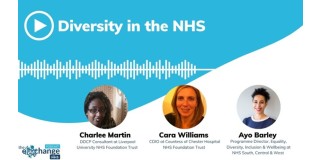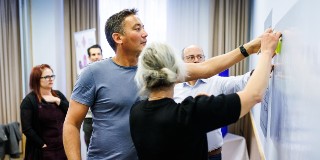What will you do differently to create a person-centred culture that fosters resilience? A great place to start is to accept that culture change can be uncomfortable, and you will, to a certain extent, need to build personal resilience to make this change happen.
Resilience is defined as ‘the ability to be happy, successful, etc. again after something difficult or bad has happened’ (the Cambridge Dictionary).
We can all empathise with the notion and aspiration of recovery, after what has been, and continues to be a testing time for individuals, families, teams and organisations. It’s important when we consider the notion of resilience, to also appreciate the nature of the environment we are living and working in, and to acknowledge and appreciate that we live in a world which is:
- Volatile
- Uncertain
- Complex
- Ambiguous (VUCA)
Leaders more than ever are operating in these unsettling environments and need to use strategies to maintain resilience to see them through the days, weeks and years of turbulence. This is no truer than in the NHS, in a period of change and pressure.
Robert Johansen, Fellow of the Institute for the Future, suggests we should counteract the ‘VUCA world’ using the VUCA Prime behavioural leadership model which includes incorporating a positive response into the four elements:
- Having a clear vision where there is volatility
- Devoting time to improving our understanding where there is uncertainty
- Focusing on clarity in the face of complexity and on what matters the most
- Being agile in response to threats, and accounting for failures
Utilising these leadership strategies is of utmost importance when looking through the lens of equality, equity, diversity and inclusion within organisations.
The last 24 months have shown us that the world globally, regionally and locally is highly complex and can be a risky place to be, particularly for those in society who are historically marginalised.
When manoeuvring around the workplace, or the healthcare system, our identity counts in a VUCA world. Colleagues have had detrimental experiences that only goes to reinforce that we, as a society. are not always operating on a level playing field.
Research tells us that those that are historically marginalised can have worse experiences than majority groups. For example:
- In 99.6% of NHS Trusts, a higher percentage of staff from the ‘Other’ ethnic group said they had experienced discrimination at work from a colleague compared to White staff (WRES, 2020)
- There is clear evidence that COVID-19 does not affect all population groups equally and death rates from COVID-19 were higher for Black and Asian ethnic groups when compared to White ethnic groups (Public Health England, 2020)
So, how do we lead effective Equality, Diversity and Inclusion strategies (EDI) in a VUCA world?
In the context of VUCA, we start by first having a clear vision and strategy for EDI. This involves:
- Improving our understanding of the different lived experiences within our workplaces
- Clarifying our purpose and priorities
- Being as transparent as possible about what we hope to achieve
- Being agile based on the changing circumstances while maintaining a focus on accountability
- Setting targets and being transparent about how well we are progressing
Perspective is everything
We must appreciate that people in general, and particularly people from underrepresented groups have different lived experiences. We need to be curious about these different experiences if we are to provide holistic, person-centred inclusion and well-being, and improve our ability to gain trust and relatability in communities that have historically not had access to, or inclusion in, our workplaces, our services, and our systems.
Creating psychological safety
At SCW, we support organisations to create psychologically safe spaces and appreciate that achieving psychological safety is more challenging for groups within the workforce that are more likely to experience discrimination, bullying or harassment.
To support creating these environments, where people feel safe to share their experiences, you can start with these first five steps:
- Ensuring everyone has a voice and a chance to be heard, showing appreciation for different viewpoints and taking a genuine interest in individuals
- Focusing on growth and development, avoiding judgement and being an active listener
- Facilitating discussions in an open and authentic way, embracing the vulnerability of doing this, and owning and acknowledging the mistakes you may make
- Including participants in the design and delivery of discussions, use your power to empower others
- Adopt a zero-tolerance approach to harassment, bullying and discrimination
What will you do differently to create a person-centred culture that fosters resilience?
A great place to start is to accept that culture change can be uncomfortable, and you will, to a certain extent, need to build personal resilience to make this change happen. Be intentional about creating spaces that may be safe for some, but may need extra effort to be safe for others, such as those who have been historically marginalised, or had poorer outcomes within work, or healthcare contexts. Be agile, and set targets to build a culture of accountability around inclusion and well-being. This helps with building trust and authenticity, and ensures, in all the efforts you make, that you listen to the voices of the most marginalised to ensure that your people and your organisation are truly person-centred.
And most importantly, be curious. Leaders must take time to authentically understand different perspectives, seek out new and emerging solutions from across their organisation, and be able to change their approaches and adapt their thinking based on the information they discover. Being a ‘humble consultant’ to the organisation can pay dividends in ensuring that ideas and solutions do not become ‘locked-in’ too soon and that every interaction can meaningfully move and shift your thinking and that of those around you.
Finally, adopting a Dialogic OD approach can support leaders in understanding that change is continuous and emergent, rather than linear, planned, and managed, and in turn, supports the need for person-centred inclusion to ensure that everyone has the opportunity to participate and shape emergent change.
For more information about equality, diversity and inclusion strategies,










